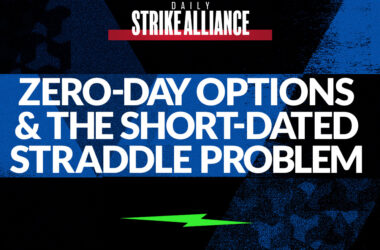Happy Monday, traders…
Ben here.
If you’ve been trading for a while now, you might have noticed one of the most frustrating aspects of the options market…
You can call the stock’s direction correctly, only to watch your position lose value anyway. Seems unfair, right?
That’s the tricky part about options. Even when your analysis is spot-on, the contracts don’t always behave how you’d expect.
However, you can avoid this shock and frustration by understanding how options contracts are priced.
There are a variety of factors that influence option pricing beyond the price of the underlying stock.
Picture a world-class chef crafting a gourmet dish. They might have a brilliant recipe, but if they don’t measure the ingredients to utter perfection, the final product won’t be as delicious (and might cost more than it should).
Well, the same goes for the ingredients of a winning options trade. Your trading strategy and pattern recognition might be excellent…
But if you don’t grasp options pricing and buy the wrong contracts, your returns will disappoint.
Today, I’ll show you exactly how options contracts are priced — so you’re never blindsided by unexpected moves in your positions.
Intrinsic Value
The first thing to understand when looking at options prices is the concept of intrinsic value.
Intrinsic value is calculated by determining how much of the contract’s total cost (or premium) is made up of the difference between the current share price and the strike price.
For example … let’s say you’re holding $105 calls on Stock XYZ, which is currently trading for $110…
If you paid $1.00 in premium for the $105 calls, then the intrinsic value of your contracts is currently $4.00.
Here’s the formula:
$110 (share price) – $105 (strike price) – $1.00 (premium) = $4.00 (intrinsic value).
Why does this matter?
Once we get to our next topic, you’ll see how much you’re paying (or how much your options are worth) beyond the actual financial value of the contract.
The higher the intrinsic value of your contracts is, the more sensitive the options will be to the moves in the underlying stock (a concept known as delta)…
…which brings me back to something we mentioned earlier.
Delta is why you can be correct on the direction of the share price and still lose money on the options.
If your contracts have a low delta (and low intrinsic value), their prices are vulnerable to change independently of the underlying share price.
This can be confusing to those new to options trading, but it’s nothing to worry about if you understand the other factors that contribute to how contracts are priced.
And that brings us to our next topic…
Extrinsic Value
The two most important aspects of options trading are direction and time.
Intrinsic value covers direction … but what about the time value of your contracts?
Time value is the extrinsic value of any options contract … it’s what you’re paying for as an options trader.
The more time is left before your contract’s expiration date, the higher its extrinsic value (and overall premium) will be.
We’ve all looked at 0DTE (days-to-expiration) contracts before. And you’ve probably noticed that they’re very inexpensive…
Well, this is due to their extrinsic value being so low.
With only a few hours left to hit your strike price, it wouldn’t make sense for market makers to charge you an arm and a leg in time value. No one would pay that.
It’s all about time decay.
The time decay will be relatively slow at the beginning of a contract’s life span. (This is measured by a metric or ‘Greek’ known as theta.)
But as the contract gets closer to its expiration date, the time decay will ramp up exponentially, causing the extrinsic value of the contract to plummet.
This is why you must understand both the intrinsic and extrinsic value of options contracts … each plays a vital role in calculating the premium you pay for the right to trade.
So many options-trading mistakes could be avoided if people understood more about how contracts are priced.
Take some time on your own to research this topic.
By doing so, you’ll get a leg up on the hoards of traders who blindly buy options without understanding how they’re priced.
Before we go, let’s look at:
💰The Biggest Smart-Money Bets of the Day💰
- $9.2 million bearish bet on TLT 01/17/2025 $94 puts @ $1.55 avg. (seen on 12/6)
- $3.3 million bullish bet on RBLX 01/17/2025 $55 calls @ $6.00 avg. (seen on 12/6)
- $2.8 million bullish bet on RIOT 01/17/2025 $15 calls @ $1.43 avg. (seen on 12/6)
Happy trading,
Ben Sturgill
P.S. TODAY, December 9 at 12 p.m. EST … Jeff Zananiri and Danny Phee are hosting an URGENT LIVE WORKSHOP to break down the biggest Burn Notice trade opportunities of the week.
Stop missing huge overnight gains — Click here now to save your seat.
*Past performance does not indicate future results





